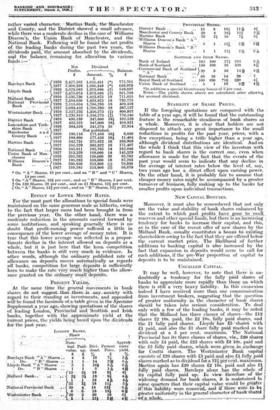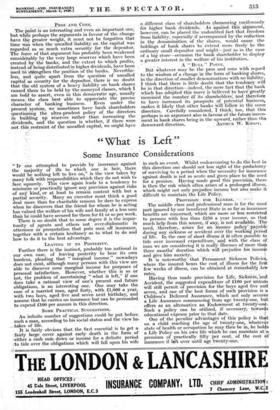Banking Profits and Bank Shares
Wrrn the exception of the Midland, all the banks in the group known as the Big Five show a small reduction in profits for the past year. A year ago it was Barclays which was the one in this group to show a slight increase, for while the Midland- and -Lancashire and - Yorkshire showed a small expansion, a slight increase in their capital played some part. On the present occasion the experiences of some of the banks in the remaining group and those whose operations are most active in the provinces, were of -a rather varied -character. - Martins-ilank; -the-Manchester and County, and the District- showed a small advance, while there was a moderate decline in the case of Williams Deacon's, the Union 13ank of Manchester, and the National Bank. Following will be found the net profits of the leading ‘banlis -during the past two years, the dividends paid, the amountabsorbed by the dividends, and the balanc remaining for allocation to various- funds:'
* On " A " Shares, 10 per cent.,-and on " B ?' and " C '- Shares, 14 per cent.
On " A" Shares, 161 per cent., and on " B " Shares, 5 per cent. On £20 Shares, 20 per cent., and on £1 Shares, 121 per cent. 110n " A" Shares, 131 per cent., and on "Et 7 Shares, 121 per cent.
EFFECT OF LOWER MONEY RATES. Dividend £ Amount. -%
1926 '2,427,162 1,651,461 (*) 1927 2,306,328 1,666,349 (5) 1926 2,523,583 1,973,886 (t) 1927' 2.475,674 1,973,886 (t) 1926 2,535,730 1,823,875 18 1927 2,554,650 1,823,875 18 1926 2,115,654 1,706,295 18 1927 2,093,452 1,706,295. 18 1926 2,157,232 1,356,275 (I) 1927 1,232,815 1,356,275 ($) 1926 450,139 347,600 181 1927 452,521 347,600 181 1926: 264,528 241,574 20
1927 Not published.
1926 186,116 177,456 1 1927 188,860 177,456 1 1926 542,731 375,822 _ 16_ 1927 555,229 383,822 16 1926 345,611 182,765 14 1927 313,329 168,000 14 1926 205,762 120,000 20 1927 195,283 108,000 18 1926 330,856 253,906 (11) 1927 310,585 253,906 () Net Profits. Balance.
775,701 639,979 549,697 501,788 711,855 730,775 409,359 387,157 800,957 776,540 102,539 104,921 22,954 8,660 11,404 166,909 171,407 162,846 145,329 85,762 87,283 76,950 56,679 Barclays Bank Lloyds Bank Midland Bank .. Nalional 'ProVincial Bank
Westminstgr-pai*
Diritrict Bank Lancashire_ and York- shire Bank • .-. Manchester a n d county Bank ..
Martins Bank National Bank ..
Union Bank of Man- chester Williams Deacon's Bank ..
For the most part the allocations to special funds were Maintained on the same generous scale as hitherto, owing to the fact that larger sums had been brought in from the- preyious year. , On the - other handi there was - moderate reduction in the amounts carried forward by some institutions, and speaking generally there is no doubt that profit-earning poWer suffered a little in consequence of the lower average of money. rates. It is true that this lower average was reflected in a propor- tionate decline in the interest allowed on deposits- as a whole, but it is just here that the keen competition between the banks is still -very much in evidence. In other words, although the ordinary published rate of allowance on deposits. moves automatically as regards all banks, competition- for large_ depoiits is sufficiently keen to make the rate eery much higher than the allow- ance granted on th6 ardina:r"
• PRESENT. YIELDS. "
At the same ;time .the general movements in bank shares do not suggest-that there -is -any anxiety with regard to their standing as investments, and appended mill be found the facsimile of -a-table given in the Spectator Supplement a year ago,-shawing quatatiOne- of the shares of leading London, Provincial and -SeOttish and Irish banks, together with the :.approximate yield at the current prices, the yieldS.,being- based upon the dividends for`, the_ ast- year. - • - - -- - LONDON Beigxs.
_ 04.are _ Nom- - APPrOk
anal Paid- Divi- Present mate value. up. dend. Price. £ £ % £ ;Barclays Bank a' A.." Shares -.. 4 4 10 7/ 1 1 14 21 -5 1 161 3A
1 1 5 1
12 •21 '18 91
Midland Bank.. - •.4 -.. 2/ 21 3 18 9/
1 1 18 4I 25 f 18 11
20 4 18 13 5 5. 18 • 181 20 5 20 19
1 1 121 211 f't
National Provincial Bank Weatmineter Bank I Do. " B."- Shares -..
• L1oirds hares S
yield. 51s 5 5 A.
41/
41- 5* • 4*
51
411 --
- 18} 114.
41
161 111 11 16 71 61 13),, 211 511 12/ 2 It 5 Is
- - Paornrcur-Exxxs.-
-District Bank .. 15 3 Manchester and County Bank 20 4 'Martins Bank .. 20 21 'Williams Deacon's Bank " A " _ 6 4 411
• Commercial Bank of Sootier:K112o 5 16 141} 5 a -,,A,, - . ,• ..•
National Bank- .. 50 10 '14 20 7
Royal Bank of Scotland .. 100 100 ;"1.g. 3.30 , 4 Tc. Union Bank of Scotland .. 5. 1 1 3 ff ' 411.
*In addition a special bicentenary bonus of 5 per cent. NoTE.-The yields shown above are calculated after. allowing for accrued dividend.
STABILITY OF ..SHARE PRICES.
If the foregoing quotations are compared the table of a year ago, it will be found-thatsthe outstanding feature is the remarkable- steadiness• of bank shares• as a whole. Moreover, it is clear that holders are not " disposed to attach any great importance to the small reductions in profits for the past year, prices, with a few exceptions, being a trifle higher than a year ago, although dividend distributions are identical. And on the whole I think that this view of the inv,estors-,Yfith regard to, bank shares is the correct .one, even, when allowance is made for the fact that the events of the past year would seem to indicate that any decline in the average of interest rates below the level of, say, two years ago has a , direet effect upon earning power. On the other hand, it is probably fair to assume that cheaper money rates might be accompanied 'by a greater turnover of- business, fully making- up to the banks for smaller profits upon individual transactions: . .
" Williams Deacon's Bank B Shares 1 1
SCOTTISH sire IRISH *BANES.
'Bank of Ireland .. 103. 100 171 283 Bank of Scotland .. 150 100 16 338 NEW CAPITAL BONUSES.
Moreover, it must also be remembered that not only- are the value and stability of bank shares enhanced by the extent to which _past arofits have gone to knell reserves and other special ftindi, but there is an gicreasing tendency for banks to increase their capital, and this, as in the case of the recent offer of new shares by the • Midland Bank, -usually -constitutes it benus to existing shareholders owing to the fact that they are offered below the current market price. The likelihood of further additions to banking capital is 'also increased by the i fact that expansion in deposits would seem to call for such additions, if the pre-War proportion of capital to deposits is to be maintained., f
UNCALLED CAPITAL.
It may be well, however, to note that there is un- doubtedly a tendency for the fully paid.• shares of banks to appreciate more rapidly than tho,se on which there is still a very heavy liability. In this connexion indeed I have received more than one communication from investment brokers, suggesting that the question of greater uniformity in the character of bank; shares should be taken into serious consideration. To deal c only with a few of the leading banks, it may be 'noted I that the Midland has Agee plasses of shares-the £12 t shares £2 10s. paid, the ,12 ..1.0s._ tiny paid shares, and f the fully paid shares. - Lloyds' has -'-sharet with t £1 paid, and also the £1 share fully paid Marked as to dividend at a 5 per cent: makimum. • The National I Provincial has its three ohisSes of shares, viz.; £20 shares With only £4 paid, the £25 shares with £3 10s. paid and the £5 fully paid shares, which were.,given in ..exclIsange for Coutts shares. The. Westminster Bank capital consists of, PO shares with g,poci,,,fiRd. also $1 fullyipaid shares marked as to diyjdend fora ) 1-pe,i7celif. maximum. Martins again has 120 shares Z2,, 10s, paid and also IX • filly_ paid shares. Barclays alone hi*. the whole.. of its capital fully paid up. In view.,: therefore. of the widening demand for bank., shares, it is maintained ln same quarters that their capital value would & (obld lie, O'er if this liability were remoYekl,rand if 'there Were greater uniformity in the general character Of banks = a.1, a whole. PROS AND CONS.
The point is an interesting and even an important one, but while perhaps the arguments in favour of the change have the greater weight, it must not be forgotten that time was when the uncalled' liabilitY on the capital was regarded: as so =much extra security for the depositor. The force of that argument has probably been weakened considerably by the very large reserves which have been created by the hanks, and the extent to 'which profits, instead of being distributed in higher dividends, have been used to strengthen the position of the banks. Neverthe- less, and quite apart from the question of uncalled capital as security for the depositor, there is no doubt that the old system of a heavy liability on bank shares caused them to be held by the moneyed classes, which I am bold to assert, even in this democratic age, usually means: the class best able to appreciate the precise character of banking business. Even under the present- 'systeiii, we 'Sometimes have bank shareholders questioning the ultra-prudent policy of the directors in building up reserves rather than increasing the dividends, and the question is whether, if there were not this restraint of the uncalled capital, we might have a: different class of shareholders clamouring vociferously higher bank: dividends: ASLaga.inst, thii.nikUment, however, can be placed the undoubted fact that freedom from liability, especially if' accompanied by the reduction in thp denomination. of the shares, would cause the holdings of bank shares to extend more freely-to the ordinary small depositor and might just' as in the case of a big store—occasion the bank shareholder to display • a greater interest in the welfare of his institution. •
A " BULL" POINT.
• r —
• But -whatever may be the pros and cons with regard • to the wisdom of a .change in the form of banking shares, in the direction of smaller denominations with no liability, I think that there is little doubt that` the. tendency will be in that direction—indeed,,the mere fact that the bank which has adoPted tfiik'inove is 4lieVed to have'Oreatly increased the numbei of its shareholders; and therefore . . to have increased its prospeets of potential business, makes it likely that other banks ‘;‘)11' follow in the:same - direction. Carefully considered, I think, too, that this perhaps is an argument also inia.Voni-of the future inove- ' ment in bank shares being in the upward, rather than the
































































 Previous page
Previous page